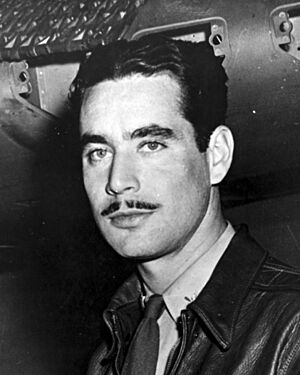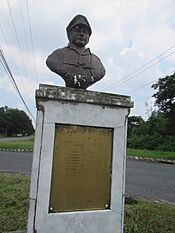Boyd Wagner facts for kids
Quick facts for kids
Boyd Wagner
|
|
|---|---|

Major Boyd Wagner
|
|
| Born | October 26, 1916 Emeigh, Pennsylvania |
| Died | November 29, 1942 (aged 26) Walton County, Florida |
| Buried |
Grandview Cemetery, Johnstown
|
| Allegiance | United States |
| Service/ |
United States Army Air Corps (1938–41) United States Army Air Forces (1941–42) |
| Years of service | 1938–1942 |
| Rank | Lieutenant Colonel |
| Commands held | 17th Pursuit Squadron |
| Battles/wars | World War II |
| Awards | Distinguished Service Cross Distinguished Flying Cross Purple Heart |
Lieutenant Colonel Boyd David "Buzz" Wagner (October 26, 1916 – November 29, 1942) was an amazing American pilot. He became the very first "fighter ace" for the United States Army Air Forces (USAAF) during World War II. A fighter ace is a pilot who has shot down five or more enemy aircraft in air-to-air combat.
Contents
Early Life and Dreams
Boyd Wagner was born on October 26, 1916, in a small town called Emeigh, in Cambria County, Pennsylvania. He grew up in Nanty-Glo, which is close to Johnstown. Boyd was very interested in planes! He studied aeronautical engineering, which is about designing and building aircraft, at the University of Pittsburgh for three years. After that, he decided to join the United States Army Air Corps, ready to fly.
Becoming a Military Pilot
Boyd Wagner finished his flight training in June 1938. He was then sent to the Philippines to serve with the 24th Pursuit Group. Soon, he was given an important job: leading the 17th Pursuit Squadron.
He earned the nickname "Buzz" because people said he was so good at flying low and fast, he could "buzz" the camouflage right off a hangar roof!
First Missions in World War II
When the Japanese launched their first air attacks on the Philippines on December 8, 1941, Wagner was a first lieutenant leading the 17th Pursuit Squadron at Nichols Field.
Just a few days later, on December 12, Wagner flew a Curtiss P-40 plane alone on a scouting mission over Aparri. While he was there, Japanese Mitsubishi A6M Zero fighter planes attacked him! He quickly dove away to escape. But then, he bravely turned back and shot down two of the enemy planes. As he was attacking a nearby Japanese airfield, more Zeros came after him. He managed to destroy two more planes before flying safely back to Clark Field.
Becoming the First Ace
On December 17, Wagner led an attack on a Japanese airstrip near Vigan. He was flying with Lieutenants Allison W. Strauss and Russell M. Church, Jr. Sadly, Lieutenant Church was killed during the attack. He was later given the Distinguished Service Cross for his bravery.
Wagner and Strauss kept going, attacking the airfield and damaging many Japanese planes. One Japanese Zero took off and attacked Wagner's plane. But Wagner was smart! He quickly slowed down his plane, which made the Zero fly past him. Once he was behind the Zero, Wagner shot it down. This victory made him the very first USAAF ace of World War II! For his amazing courage, he also received the Distinguished Service Cross.
Wagner attacked the Japanese again at Vigan on December 22. This time, his plane was hit by enemy fire, and glass splinters wounded his face and eyes. Even with his injuries, he managed to fly his plane safely back to base. In January 1942, he was sent to Australia to recover.
Promotion and New Role
In April 1942, Wagner was promoted to lieutenant colonel. This was a big deal because he was the youngest lieutenant colonel in the U.S. Army at that time! He was assigned to the 8th Fighter Group in New Guinea, where he flew the Bell P-39 plane. On April 30, 1942, he shot down three more Japanese Zeros, bringing his total number of air victories to eight!
Because of his valuable experience and knowledge, it was decided that Wagner would be more helpful back in the United States. His new job was to train other fighter pilots and work with engineers at the Curtiss P-40 plane factory in Buffalo, New York. He would help them make the P-40 even better for combat. Even though he wanted to stay in combat, he was sent home.
Tragic Disappearance
On November 29, 1942, Lieutenant Colonel Wagner was on a normal flight in a P-40K plane. He was flying from Eglin Field, Florida to Maxwell Field, Alabama. But his plane disappeared.
A huge search began. Almost six weeks later, in January 1943, what was left of his P-40 plane and Wagner's remains were found about 25 miles east of Eglin. The exact reason for the crash was never publicly shared.
Part of Wagner's remains were brought back to Johnstown, Pennsylvania, for burial. Between 15,000 and 20,000 people came to his funeral at Grandview Cemetery in January 1943. Both Time and Life magazines wrote about the event.
Years later, in 2008, more human remains were found at what was believed to be the crash site in Florida. In 2010, these remains were confirmed to be Lieutenant Colonel Wagner's. These additional remains were buried with full military honors, including a flyover by the U.S. Air Force, at the Grandview Cemetery in Johnstown, Pennsylvania.
Honors and Awards
 |
||
|
|
| United States Army Air Forces pilot badge | |||
| Distinguished Service Cross | Distinguished Flying Cross | ||
| Purple Heart | American Defense Service Medal with service star |
American Campaign Medal | |
| Asiatic-Pacific Campaign Medal with three bronze campaign stars |
World War II Victory Medal | Philippine Defense Medal | |
|
|
| Army Presidential Unit Citation with bronze oak leaf cluster |
Philippine Presidential Unit Citation |
See also
- History of Clark Air Base
- List of solved missing person cases
- List of World War II flying aces




